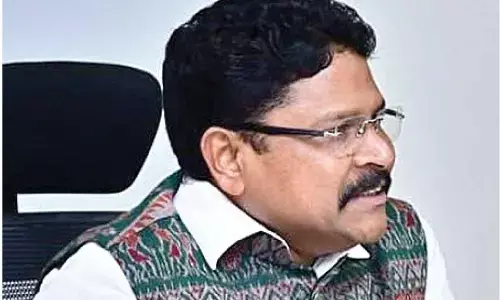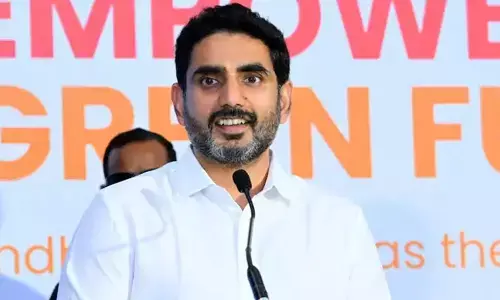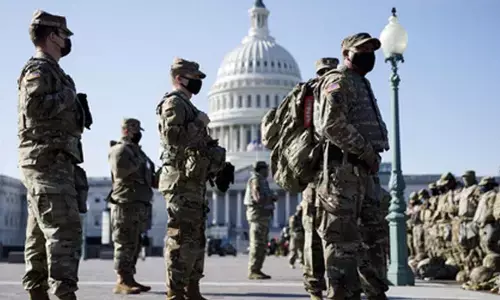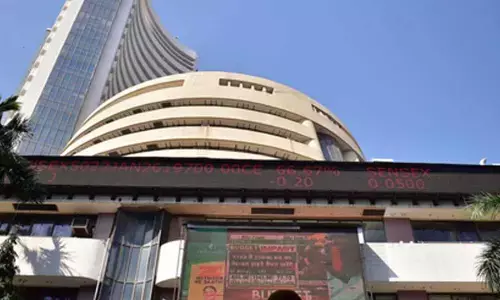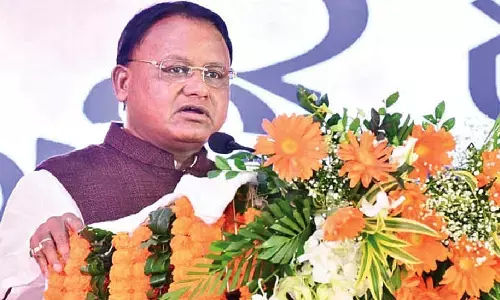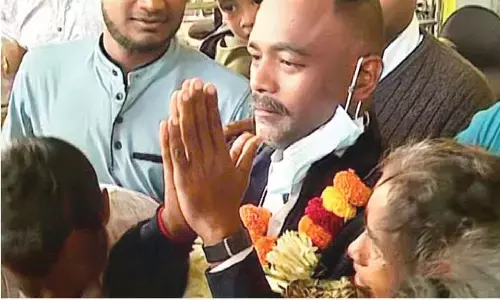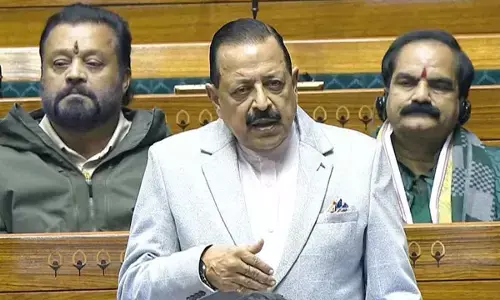Will Chandrababu Embrace Modi?

The time appears to have arrived for TDP chief Chandrababu Naidu to strike back at the empire. Naidu has been waiting all these years for a window of opportunity to open. After the decks were cleared for Gujarat strongman Narendra Modi to be anointed as the BJP’s prime ministerial candidate, the national political scenario has acquired greater clarity.
The TDP chief figured out that breaking bread with NaMo is the only way forward. There are at least five reasons why Naidu would jump on the Modi bandwagon
K RAMACHANDRA MURTHY
The time appears to have arrived for TDP chief Chandrababu Naidu to strike back at the empire. Naidu has been waiting all these years for a window of opportunity to open. After the decks were cleared for Gujarat strongman Narendra Modi to be anointed as the BJP’s prime ministerial candidate, the national political scenario has acquired greater clarity. Narendra Modi would be at the helm of the BJP during the election campaign. Leaders of all parties across the country, including those who have been dealing with the patriarch Lal Krishna Advani over a couple of decades, now have to tune to Modi. Naidu is undertaking precisely that kind of reorientation.
I wrote recently when Naidu was doing his bus journey in Guntur district that the former chief minister is looking like “a great warrior who lost his way.” He appears to have found the way forward at last, luckily for him and his party, in time for the general election. The TDP chief figured out that breaking bread with NaMo is the only way forward. There are at least four reasons why Naidu would be willing to jump on the Modi bandwagon.
Seething with anger
First, Naidu has to avenge the humiliation of successive defeats and marginalization. Behind the cheerful façade, a furious inferno has been raging in the TDP leader’s heart. He realized long ago that the politics played by the Congress party under the leadership of Sonia Gandhi throughout the second decade of the 21st century in Andhra Pradesh was to finish him politically. He used all his wits, guile, will power and energy to keep fighting. He was able to retain the leaders and the cadre by dint of hard work and eternal vigilance. But he could not win over the people. He went to the extent of aligning with the Telangana Rashtra Samiti (TRS), a party whose sole agenda is statehood for Telangana. Naidu went by intuition and against his heart.
He could not succeed. The decision of the CWC caught him unawares. He was not expecting Sonia to act. When she did, he was found wanting in responding appropriately. To start with, he said Seemandhra needs five lakh crores to build a new capital. Then he began to question the way the decision was taken. After the people in Seemandhra came into the streets in a big way, he realized that he was overtaken by the events.

YSRCP has stolen a march on him by quickly vacating Telangana and concentrating on Seemandhra where the party’s leaders are championing the unity of the State. He strongly suspects that the Congress and the YSRCP have a secret understanding to share the two regions between them and then pool up seats after the polls. He is prepared to do anything and take any risk to counter the strategy of the Congress and the YSRCP. He has been looking for an opportunity to break the jinx. Narendra Modi’s elevation has provided one.
Modi’s olive branch
Second, Narendra Modi is a serious challenger to the Congress at the national level. The Left parties, cultivated assiduously by Naidu over the years after snapping ties with the BJP, are not in a position to give a fight to the ruling party. They are confined to a few States. The urban, educated and upwardly mobile youth is admiring Modi. The corporate honchos are praying for him. The upper middle class is worshipping him. After the riots in 2002, Naidu had criticised Modi and followed it up by severing ties with the BJP. He even mounted a personal attack on Modi. But in politics, loyalties and relationships keep changing. When Modi visited Hyderabad to address a youth gathering in August, he remembered NTR and conveyed his desire for a renewal of relationship with the TDP. Modi has his game plan. He needs at least 40 Lok Sabha seats from the South.
Jayalalithaa is expected to win about 25 seats in Tamil Nadu. With Advani loyalist Ananth Kumar being sidelined and Yeddyurappa brought back into the fold, the BJP can hope to bag 5 to 8 seats in Karnataka. If TDP-BJP combination can capture about 10 seats in AP, it would be easy for NDA to form government in Delhi. Hence, the olive branch; and which Naidu is now eager to grab with both the hands. Both Modi and Naidu are prepared to forget and forgive. The protagonists of market-friendly politics hope that they would form a formidable combination and may even create a magic of sorts in AP.
Stalling bifurcation, if possible
Third, which brings us to the decision on bifurcating the State. The BJP has been supporting the Telangana statehood movement. Sushma Swaraj, the Leader of the Opposition in the Lok Sabha, addressed three well-attended meetings in Telangana vociferously supporting the cause. When BJP president Rajnath Singh came to Hyderabad to admit Nagam Janardhan Reddy, former TDP minister, into the party, he promised that his party would not have electoral understanding with any party which is opposed to Telangana statehood.
The TDP also gave a letter to the Pranab Mukherjee Committee supporting bifurcation of the State. It reiterated its stand recently. But, after the CWC announced its decision to bifurcate AP, both the BJP and TDP have been cautiously drifting from their stand and have questioned the manner in which the Congress party took the decision. Narendra Modi was the first to seize the opportunity and flay the ruling party for dividing the Telugu people instead of bifurcating the State. He reminded the people that when the NDA government created three new States, the people of Madhya Pradesh and Chhattisgarh; Uttar Pradesh and Uttarakhand; and Bihar and Jharkhand celebrated by distributing sweets.
The Telugus, on the contrary, are bitterly divided due to the inept manner in which the Congress party and the UPA government handled the sensitive issue. Even Sushma is reported to have quipped that the BJP cannot be expected to provide the ceremonial music when somebody is performing a marriage. Naidu, on his part, told the people during his bus journey that he would stand by the Seemandhra people in their struggle till the end, whatever it means. He has taken a break to visit Delhi on the 21st or the 22nd probably to negotiate with the BJP leadership. If the
BJP holds back its support to the Telangana Bill in Parliament, it will be difficult for the UPA to get it passed. 19 Congress MPs from Seemandhra may defy the party whip to safeguard their own political future.
Though Naidu has been saying that he is not against Telangana statehood, he is perceived as a strong integrationist. If the Bill can be thwarted and the political discourse in the State shifted from acrimony to development, the Congress game plan would go haywire. The TDP-BJP combine may not get any Lok Sabha seat in Telangana (the BJP leaders in Telangana would not approve of a reversal of the decision), but it can give a tough fight to YSRCP in Seemandhra.
If that shift is perceived to be too opportunistic bordering betrayal, both Modi and Naidu can promise an attractive package for the people in Seemandhra and facilitate smooth bifurcation. This option may not yield desired results in Seemandhra. But it can hope to pick up a few seats in Telangana. YSRCP will continue to have the sway in Seemandhra and Congress would claim credit for creating the State of Telangana. In both the regions, the TDP-BJP combine cannot hope for a large number of seats. No party, or a combination of parties, is in a position to satisfy the people in both the regions. If one has to choose between the regions, it is 25 versus 17 (It is, in fact, 16 with Hyderabad sure to be retained by the MIM) Lok Sabha seats and the choice is obvious.
Backpedaling on two issues
Naidu has to explain his backpedaling on two important issues: 1) TDP stand on bifurcation 2) TDP’s policy towards the BJP. Naidu can continue to be as vague and evasive as he has been on the question of bifurcation. His decision to go for electoral pact with the TRS in the 2009 elections had affected his party adversely in Seemandhra region. He has an opportunity now to correct the mistake. Once the bifurcation is prevented, and elections take place in united AP, and TDP manages to win a simple majority, Naidu is confident of persuading the people of Telangana not to press for separate statehood.
With power in the State and proximity to the Centre (in case Modi becomes PM with critical dependence on TDP support), Naidu can resolve the crisis by offering positions and pelf to politicians who matter. In fact, this is what he planned to do after winning in the 2009 elections: to deal with the TRS post-elections, the same way that YS Rajasekhara Reddy did after the 2004 elections. But the strategy backfired. Naidu is a robust optimist and would pursue the new leads that come his way.
Explaining his decision to reverse the TDP policy towards the BJP is not a problem. Having majored in Economics, it is not difficult for him to analyze why the economy is in a mess under the UPA dispensation.
No wonder, he was referring to the falling rupee and rising prices of essential commodities. In the name of saving the country from bankruptcy and putting it back on the trajectory of progress and development, he can justify his own about-face. Changing the tack and explaining it away is not very difficult in AP where party colleagues and media persons are not used to asking inconvenient questions.
The TDP leaders in Seemandhra did not a say a word against Naidu’s decision to support Telangana cause and go for electoral understanding with the TRS. The party leaders both in Seemandhra and Telangana did not object when Naidu dumped the Communist parties in favour of the BJP; then delinked the BJP, and linked back to the Communists in 2009. Ditto with the Congress party. No questions were asked when the Congress had a tie up with the TRS in the 2004 elections and there were no qualms about dropping the TRS ministers after a few months in office. All regional and national parties have been doing this tightrope walk. Coalitions undermine loyalties. The DMK, the AIADMK, Trinamool Congress, Samajwadi Party and Bahujan Samaj Party have had tie-ups with the Congress and the BJP alternately. The only exception is the TDP, a viable alternative to the Congress in the State. PRP could not sustain itself and the YSRCP is yet to be tested.
Fourth, instead of fighting a lonely battle in both the regions and losing abjectly, it is better to take a risk, even if it is a huge one, and fight it out. There is nothing significant for the TDP to lose. A never- say-die pugilist that he is, Naidu is determined to have a relationship with Modi to take on the Congress-YSRCP combine. Politics makes strange bedfellows. Naidu was the first poster boy of Indian economic reforms. He was the first chief minister to go all-out in implementing reforms which helped him to make it to ‘Time’ magazine cover. What Narendra Modi, the latest symbol of reforms and the favourite of the market, did was only to follow his AP counterpart when he took over the reins of Gujarat. We are watching the first mascot of reforms courting the best and the latest.




